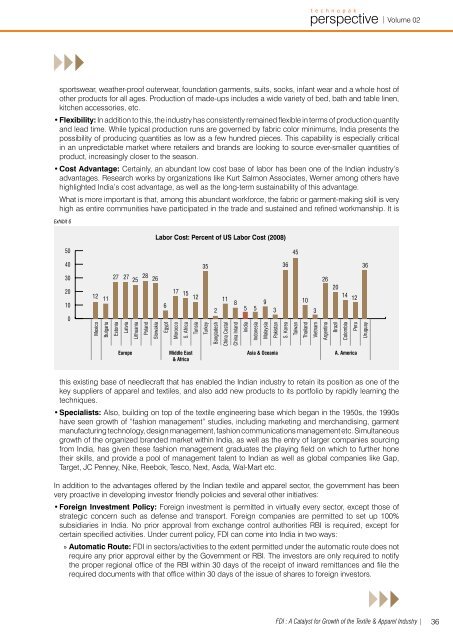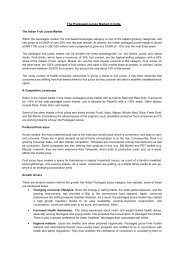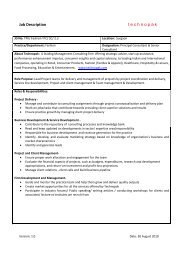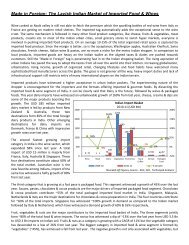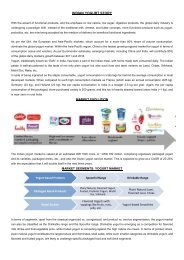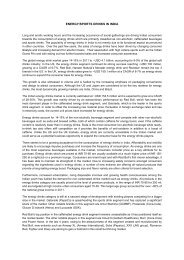a quarterly report by - Technopak
a quarterly report by - Technopak
a quarterly report by - Technopak
Create successful ePaper yourself
Turn your PDF publications into a flip-book with our unique Google optimized e-Paper software.
perspective<br />
a quar terly repor t <strong>by</strong><br />
Volume 02 / 2009<br />
| Volume 02<br />
sportswear, weather-proof outerwear, foundation garments, suits, socks, infant wear and a whole host of<br />
other products for all ages. Production of made-ups includes a wide variety of bed, bath and table linen,<br />
kitchen accessories, etc.<br />
• Flexibility: In addition to this, the industry has consistently remained flexible in terms of production quantity<br />
and lead time. While typical production runs are governed <strong>by</strong> fabric color minimums, India presents the<br />
possibility of producing quantities as low as a few hundred pieces. This capability is especially critical<br />
in an unpredictable market where retailers and brands are looking to source ever-smaller quantities of<br />
product, increasingly closer to the season.<br />
•Cost Advantage: Certainly, an abundant low cost base of labor has been one of the Indian industry’s<br />
advantages. Research works <strong>by</strong> organizations like Kurt Salmon Associates, Werner among others have<br />
highlighted India’s cost advantage, as well as the long-term sustainability of this advantage.<br />
What is more important is that, among this abundant workforce, the fabric or garment-making skill is very<br />
high as entire communities have participated in the trade and sustained and refined workmanship. It is<br />
Exhibit 6<br />
50<br />
40<br />
30<br />
20<br />
10<br />
0<br />
12 11<br />
Mexico<br />
Bulgaria<br />
27 27 25 28 26<br />
Estonia<br />
Latvia<br />
Lithuania<br />
Poland<br />
Slowakia<br />
Europe Middle East<br />
& Africa<br />
Labor Cost: Percent of US Labor Cost (2008)<br />
6<br />
Egypt<br />
17 15 12<br />
Morocco<br />
S. Africa<br />
Tunsia<br />
35<br />
Turkey<br />
2<br />
Bangladesh<br />
11<br />
China Costal<br />
Asia & Oceania A. America<br />
this existing base of needlecraft that has enabled the Indian industry to retain its position as one of the<br />
key suppliers of apparel and textiles, and also add new products to its portfolio <strong>by</strong> rapidly learning the<br />
techniques.<br />
•Specialists: Also, building on top of the textile engineering base which began in the 1950s, the 1990s<br />
have seen growth of “fashion management” studies, including marketing and merchandising, garment<br />
manufacturing technology, design management, fashion communications management etc. Simultaneous<br />
growth of the organized branded market within India, as well as the entry of larger companies sourcing<br />
from India, has given these fashion management graduates the playing field on which to further hone<br />
their skills, and provide a pool of management talent to Indian as well as global companies like Gap,<br />
Target, JC Penney, Nike, Reebok, Tesco, Next, Asda, Wal-Mart etc.<br />
In addition to the advantages offered <strong>by</strong> the Indian textile and apparel sector, the government has been<br />
very proactive in developing investor friendly policies and several other initiatives:<br />
• Foreign Investment Policy: Foreign investment is permitted in virtually every sector, except those of<br />
strategic concern such as defense and transport. Foreign companies are permitted to set up 100%<br />
subsidiaries in India. No prior approval from exchange control authorities RBI is required, except for<br />
certain specified activities. Under current policy, FDI can come into India in two ways:<br />
» Automatic Route: FDI in sectors/activities to the extent permitted under the automatic route does not<br />
require any prior approval either <strong>by</strong> the Government or RBI. The investors are only required to notify<br />
the proper regional office of the RBI within 30 days of the receipt of inward remittances and file the<br />
required documents with that office within 30 days of the issue of shares to foreign investors.<br />
8<br />
China Inland<br />
5 5<br />
Inidia<br />
Indonesia<br />
9<br />
Malaysia<br />
3<br />
Pakistan<br />
36<br />
S. Korea<br />
45<br />
Taiwan<br />
10<br />
Thailand<br />
3<br />
Vietnam<br />
26<br />
Argentina<br />
20<br />
Brazil<br />
14 12<br />
Colombia<br />
Peru<br />
FDI : A Catalyst for Growth of the Textile & Apparel Industry |<br />
36<br />
Uruguay<br />
36


